Shield Bugs 101: Wonders Of Families Pentatomidae & Cydnidae
One of the easiest groups of bugs to find and identify is the Shield Bugs.
There are about 6,500 species in the world and about 40 in Britain. In Britain, the Shield Bugs are represented by four different families; Cydnidae, Acanthosomatidae, Pentatomidae, and Scutelleridae.
Generally, they are flattish oval or shield-shaped bugs (hence their common names), ranging from 5 – 35 mm in length. The Cydnidae tend to be darkly coloured, however, some species are quite beautiful, i.e. Sehirus bicolor which is black and cream.
The Acanthosomatidae are mostly green and/or brown; while the Pentatomidae are often more colourful, i.e. Eurydema dominulus which is orange and black; and Zicrona caerulae which is a deep bluish purple.
In the Cydnidae, Acanthosomatidae, and Pentatomidae the adults have five antennal segments, and the nymphs only four. The nymphs all go through 5 instars (the period between two moults) to become adults.
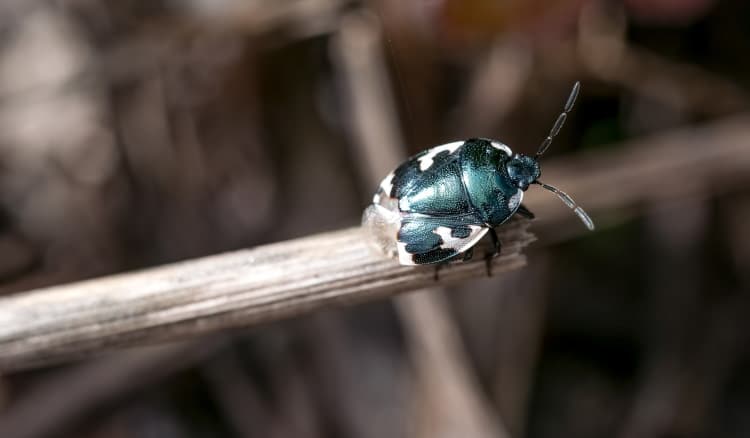
Shield bugs are mainly phytophagous (feeding on plant sap), though a few are carnivorous and may even be useful in controlling pests (see below).
They are often called Stink Bugs because they can produce a horrible smell.
In adults, the noxiously smelling fluid is produced by a pair of glands in the thorax and released via a pair of pits on the metathorax. In the nymphs, there are 3 pairs of scent glands in the abdomen and the liquid is released through special openings in between the 3/4, the 4/5, and the 5/6 abdominal segments.
The scent does work though. It is known to repel certain vertebrate predators; in some species, it will strongly stain your fingers like iodine – and the smell gets right up your nose. It’s so corrosive, that it can even cause temporary blindness if it gets in your eye!
Some Shield Bugs are pests, i.e. Murgantia histrionica, the Harlequin bug which is a pest of cabbages; Antestiopsis spp. which is a pest on coffee and Nezara viridula which is cosmopolitan (found all over the world) and a pest of a wide range of common crops such as tomatoes, beans and cotton.
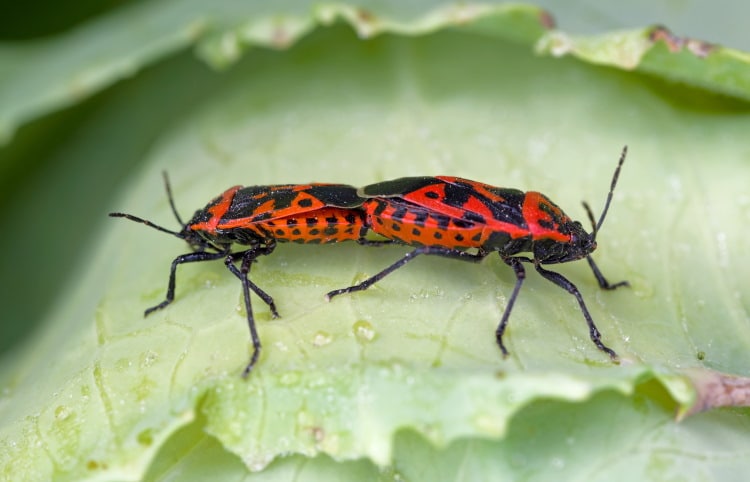
The phytophagous Shield Bugs all have symbiotic bacteria in their guts, to help them digest the food they eat. The eggs are smeared with an inoculation of these symbionts when laid, which ensures that the young (which eat their eggshell on hatching) have enough of them to digest their next meal.
In opposition to this, most members of the subfamily Amyoteinae are predacious and useful controllers of other pests – as they feed primarily on caterpillars (Lepidoptera) and larvae of Leaf Beetles (Chrysomelidae). We have 4 members of that subfamily in Britain, Zicrona caerulea, Picromerus Bidens, Troilus luridus, and Rhacognathus punctatus
The Cydnidae
Cydnidae is often darkly coloured and commonly referred to as ‘Negro Bugs’. There are about 400 species worldwide, most of which are burrowing species that feed on the roots of plants and live under stones or logs or in leaf litter.
In Britain, only 1 of our 8 species follows this life cycle; the rest feed on above-ground parts of plants, for instance, Sehirus bicolor feeds on White Dead Nettle (Lamium album).
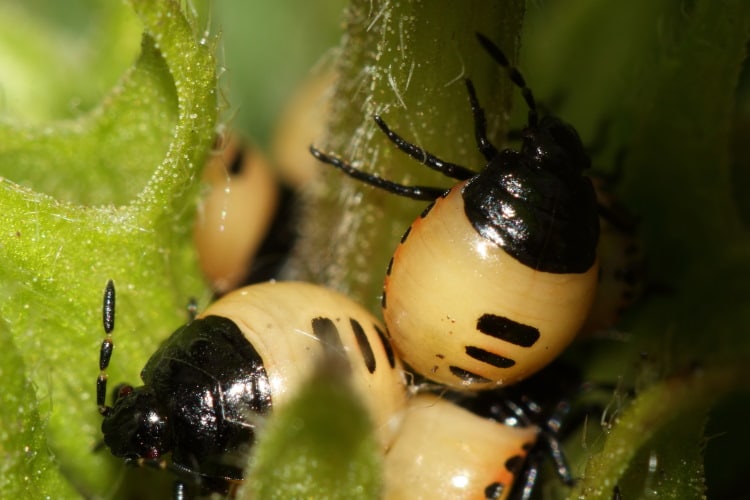
The burrowing habit is not completely lost though, as it burrows into the leaf litter over winter and digs a hole in the soil in which to lay its eggs. Like other members of the Cydnidae, S. bicolor lays about 40 eggs which the female guards until they hatch in early spring or summer. They have a row of pegs on the hind wing, which when rubbed across a horny ridge on the abdomen produce a sound. This sound is important in courtship.
Acanthosomatidae
The Hawthorn Shield Bug (Acanthosoma haemorrhoidal) is relatively easy to find and is a good example of a typical ‘Shield Bug’. It feeds preferentially on Hawthorn Berries but will feed on the leaves when berries are not available. It will also feed on White Beam and Oak.
The adults over-winter in crevices in trees, under pieces of bark, or in grass tussocks. They emerge in April and the eggs are laid on leaves in batches of up to 24; the nymphs hatch shortly after and look very much like miniature adults.
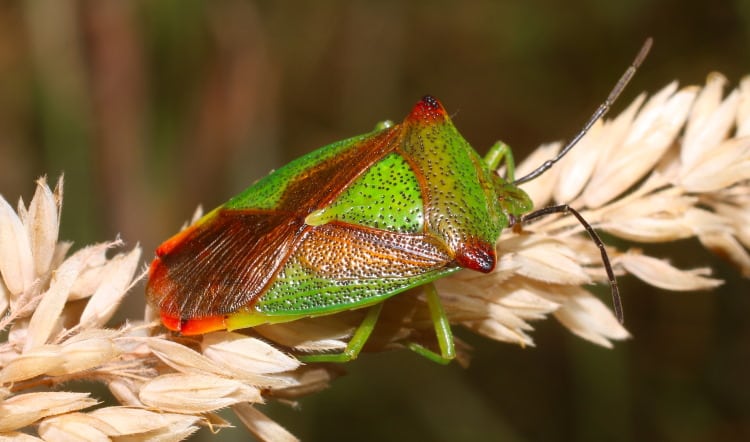
Besides the Hawthorn Shield Bug, we have four other Acanthosomatids in Britain and three of them are in the genus Elasmostethus.
E. interstinctus is The Birch Shield Bug, which as its name implies feeds primarily on Birch trees – but it will use Hazel and Aspen as well. It lays its eggs in May a bit later than the Hawthorn Shield Bug, but otherwise, its lifecycle is fairly similar.
E. ferrugata is the Billberry Shield Bug and is very rare. E. grisea the Motherly Shield Bug was first reported guarding and caring for its eggs and young in 1764 and was the first of many Heteropterans to be recorded showing this habit. They feed on Birch and the adults – which hibernate in leaf litter and similar places – emerge in May.
Eggs are laid in early June, hatch out by the end of the month, and collect together a little distance from the old eggs. After about ten days they moult into the second instar and now follow the female, who has been guarding them all this time, wherever she goes.
Scutelleridae
These have an enlarged mesoscutellum (the plate covering the middle thoracic segment) which extends backward to cover the abdomen and the wings. They are mostly tropical or subtropical and about 400 species have been named so far – and all are phytophagous.
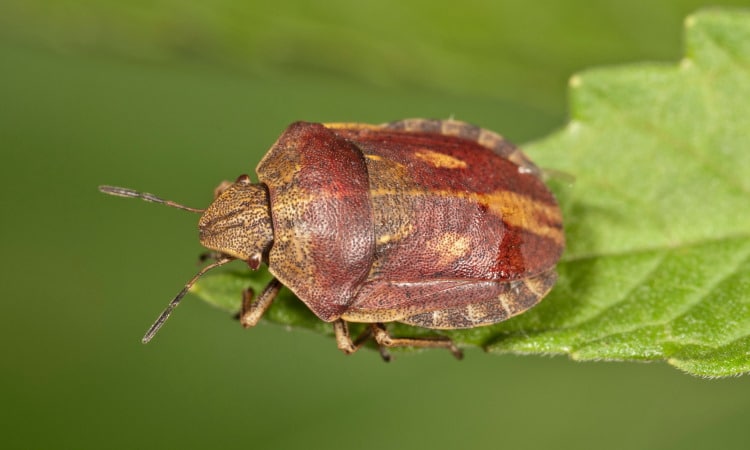
We have three members of the genus Eurygaster in Britain, E. austriaca, E. maura, and E. testudinaria. E austriaca is rare in Britain, as it is at the northerly tip of its range. It is a pest of some economic importance on cereals in southern Europe, but not here in Britain.
E. Maura, known as the European Tortoise Bug, feeds on a wide range of plants and has the interesting habit of feigning death and falling off its food plant if disturbed.
Our two species of Odontoscelis are reasonably tricky to find, as they spend most of their time beneath the soil. Or more often beneath the sand, as they always occur near the coast either over-wintering near or feeding on plant roots.
Pentatomidae
Pentatomidae is by far the largest family of Shield Bugs, making up half of the British fauna but four-fifths of the world’s fauna; a total of 5,000 species have so far been described.
Most are phytophagous but some are predacious. Of the phytophagous species, a few such as Murgantia histrionica the Harlequin bug, are pests – in this case, cabbages and other related plants.
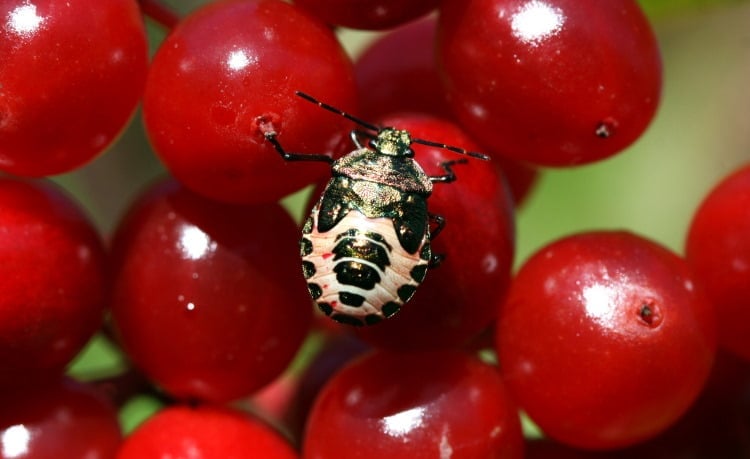
Troilus luridus is the lovely Latin name of the Bronze Shield Bug which lives in both deciduous and coniferous woodlands. This is one of the four carnivorous Pentatomidae species we have in Britain, which is quite useful because it feeds on phytophagous insects in trees.
When the eggs first hatch though, the young feed on the sap of the plants themselves, but then from their second instar onwards they are predacious. They over-winter as adults, mostly in moss, or bark crevices. They emerge later in the season than the wholly phytophagous Shield Bugs – because they need to wait for their prey to grow and become worth eating first.
The barrel-shaped eggs are generally laid in regular patterns around pine needles and small twigs in late May and Early June. Though only 20 or so are laid at one time, numerous batches may be laid and one female will probably lay about 200 eggs.
Plataspidae
These are mostly tropical and mainly restricted to the Eastern Hemisphere; they are nearly all phytophagous, though some are fungivorous (feed on fungi). There are about 500 species named worldwide; none occur in the UK.
Tessaratomidae
These are commonly known as the Giant Shield Bugs and can reach 15 mm in length; they are phytophagous and some have achieved pest status in some places, i.e. on citrus in Australia. There are about 250 named species.
What Next?
Well, I hope this has been an interesting introduction to the world of the Shieldbugs.
Perhaps now you’d be interested to learn a little more about lace bugs.
Bibliography
- Dolling, W. R. (1991) The Hemiptera, Oxford University Press.
- Evans, J.W. (1963) The Phylogeny of the Homoptera, Annual Review of Entomology, 8 pp 77-94.
- Miller, N.C.E. (1971) The Biology of the Heteroptera 2nd Ed. Hill, London.
- Slater, J.A. and Baranowski, R.M. (1978) How to Know the True Bugs (Hemiptera-Heteroptera) William Brown, Dubuque, Iowa.
- Southwood, T.R.E. and Leston D. (1959) Land and Water Bugs of The British Isles Warne, London.
- Stondahl, G.M. and Dolling, W.R. (1991) Heteroptera identification: A reference guide, with special emphasis on economic groups, Journal of Natural History, 25 pp 1027-1066
Nymph Image license: Creative Commons

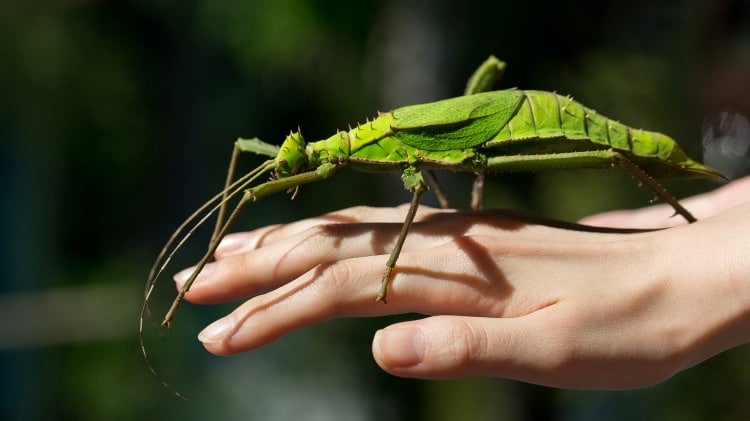

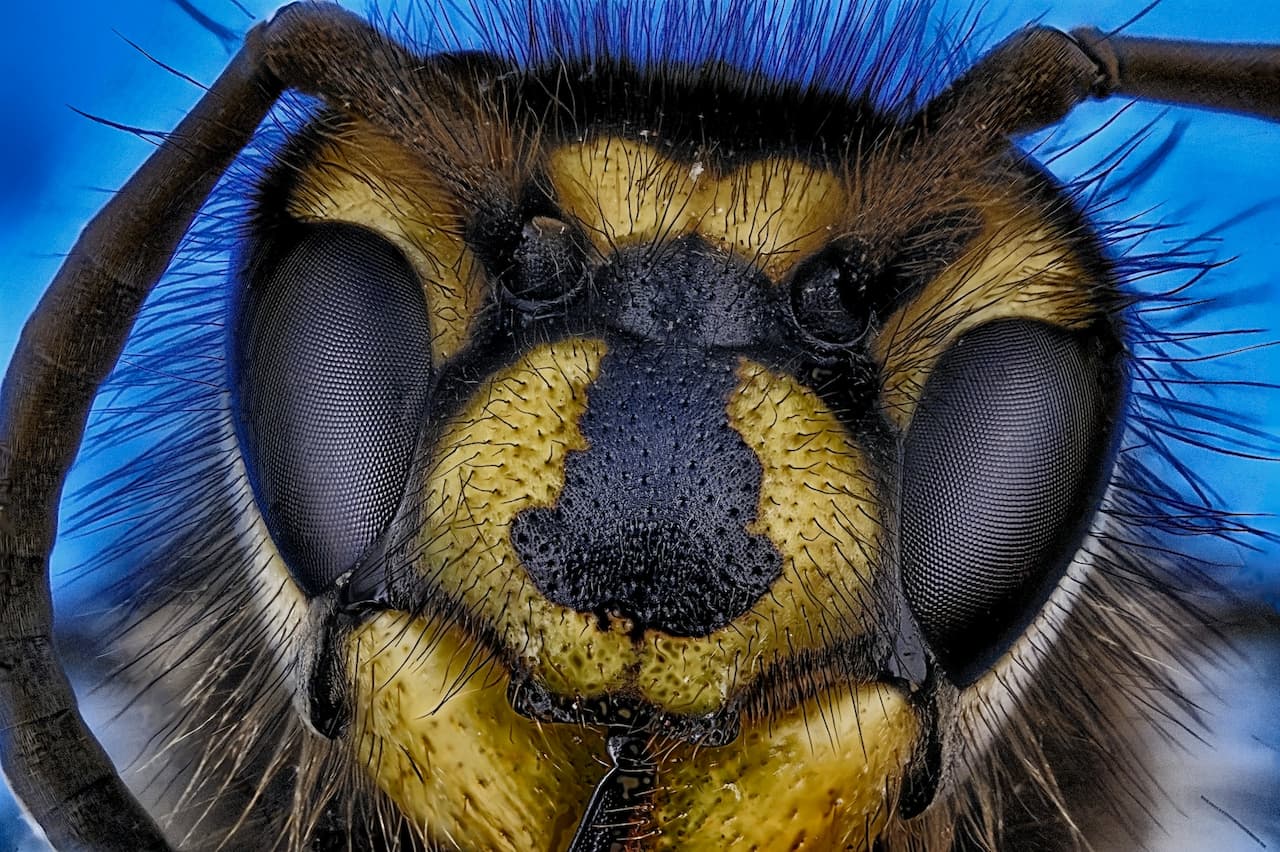
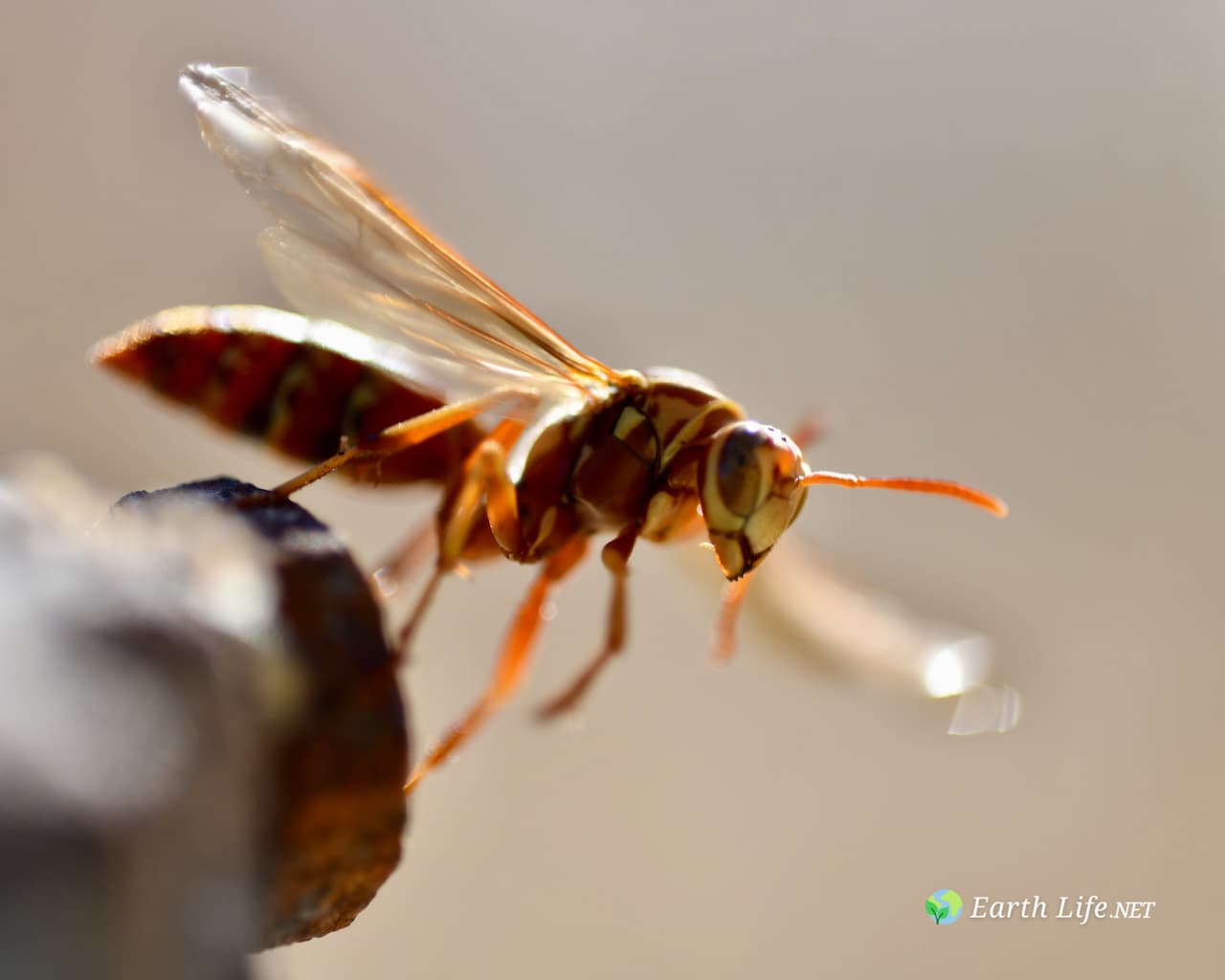
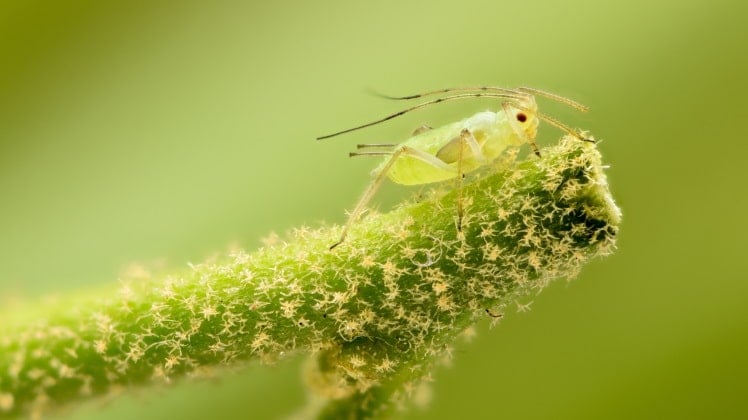
Hello Gordon,
I like your intro.
I have just found a clutch of perhaps 20-30 pretty green eggs, like miniature grapes, on the underside of a tomato leaf. This is in Brittany. Looking at websites suggests these are shield bug eggs. Unfortunately most the sites only have photos of adults, with a particular predilection for copulating pairs. So I can’t be sure if hatched nymphs are likely to attack my plants or not. At the moment I have let them be. Can you give me some more data please?
Are all shield bug stinky?
Not necessarily. Shield bug is generally a British term, the America counterpart is Stink Bug. Neither of these is a scientific term and usage is variable. Stink Bug generally refers only to members of the Pentatomidae, whilst Shield Bug can include a much larger range of hemipteran families i.e. Acanthosomatidae, Scutelleridae, and Cydnidae. All Pentatomids, and many other hemipterans, produce smelly substances as a defensive spray, but not all these smells are called a ‘stink’ some are rather pleasant.
This year I have tons of shield bugs or stink bugs. I killed ninety in a day. Are they dangerous in any way?
Should I contact someone about this bug? I really only see them on my house and inside porch. Very creepy
bug.
Hi Charlotte,
If you are noticing them now, in the fall, on your house it may be that they are looking to find a dry place to sleep out the winter. Are they dangerous, they are plant sap suckers, in large or even moderate numbers they can be pretty bad for your plants. They will not attack you and the smell they emit is horrible on the nostrils, but not harmful otherwise. I would try to avoid calling an expert, besides the cost they use poisons and this planet is poisoned enough already. If they really are nuisance, collect them in a bucket and hit them with boiling water. Stand back straight away.